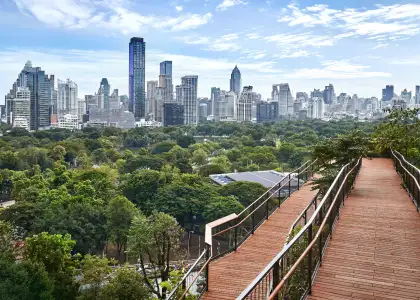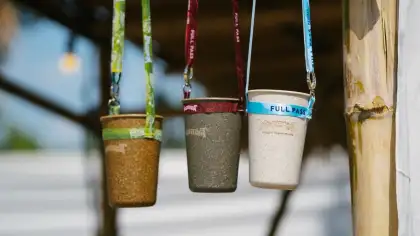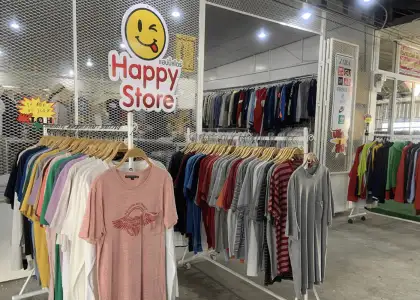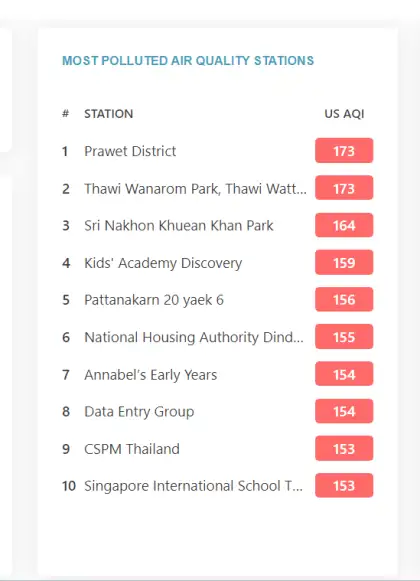This Thai Social Activist-Artist Proves Her Radical Love for Nature By ‘Turning Trash into Treasure’

There’s no denying that raising environmental awareness is not as trendy as fitness, fashion, or beauty, while the rapid expansion of industrialisation over the years has changed our lives and damaged the environment dramatically.
Waste materials are major contributors to the worsening situation of climate change and pollution, leading to degradation of the ecosystem and extinction of various species. It may be a little too late but reversing and minimising the human impact is the only powerful way to save the planet for future generations.
A young social activist and artist from Bangkok, Wishulada “Aye” Panthanuvong, who is also the founder of Turn to Art Co., Ltd, blended her interest in arts and the environment to promote awareness and inspire more people to take action against environmental problems.

Since she was younger, Aye always wanted to become an artist, which is why she pursued a degree in the Faculty of Fine and Applied Arts at Chulalongkorn University. While there, she learned about products’ materials, textures, and art installations. However, her interest shifted during her last year at the university when she finished a project related to human-caused waste materials and environmental consumption, which she considers her first piece of work before she became one of the successful artists that we know today.
Aye has been creating artworks from waste for almost a decade now, but her belief in art’s power remains strong: “Art is an instrument to change people’s ideas and artwork is a useful channel to convey idea and message from artist to audience.”
In this exclusive interview, The Beat Asia got the chance to talk to Wishulada “Aye” Panthanuvong about her artistic ways of saving the planet.
Tell us about yourself before getting involved in environmental activism
Since I was young, there are many methods that my family used to handle waste materials such as my dad [who] always repairs every broken thing instead of buying a new one. We usually collect plastic coffee cups or plastic containers to reuse, and I learn to separate newspapers, used paper, plastic bottles, and some electronic devices or metals and sell them.
Moreover, the news in Thailand about solutions [to] global warming inspired me. They mentioned about people throwing garbage into the rivers, soil degradation and deforestation are worsening. I think that it is time to take charge and make a difference. I hold on to the principles of the Sustainable Development Goals (SDGs)… my work is related to SDG’s goal number 12 [or also referred to as] responsible consumption and production.
I got inspiration from watching animal documentaries, especially the fighting and survival ones or fantasy movies. Moreover, my hobby is taking a walk in hardware stores such as Thai Watsadu Ikea or Home Pro to look around the construction materials and get inspiration from their [products’] unusual shape and colourful ones.
Can you share with us about your trash separation business and how you manage it?
I would like to raise awareness about how reused materials [become] valuable based on the principles of Circular Economy System and make inspiration about waste materials management such as reuse, reduce and repair. This change can reduce natural resource consumption and waste. I believe that when people’s ideas are changed, lifestyle will be changed and finally, the environmental issue can be [resolved].
The distinctive points in my work are [its] colourfulness and variety of materials. Moreover, my artworks can be applied with many styles of presentation and techniques to reach every group of audience.

In [the] case of creative voice, my artwork [acts as] a channel to communicate abstract to be substantial. My process of [creating] artwork [includes] finding inspiration and searching information to get the artwork concept, design draft of the artwork, set materials [to be] used in the artwork, create the artwork and set up, prepare reused materials from bins / donate / and buy waste from people. After I set up the art piece, I have a team to keep waste materials and clean them for next time. I would [also] like to set up a a Zero Waste and Circular Economy Concept in my art pieces.

What first drew you to environmental activism?
Because [the] younger generation will continue to live in this world and need natural resources to survive, it will be better if they [are] more concerned about the environment and natural resources.
I usually do collaborations with various sectors and everyone who works with me will [gain] some knowledge or ideas about how to manage waste materials and create useful products. These know-hows can reach [more] people at the community level as well. I hope that this will spark ideas to create valuable products from waste materials in their community and urge awareness of their responsibility for the environment.
So, if everyone can see the value starting from a [small] step of reducing waste materials and understand the strong relationship [between] us, as a human, objects, [and] a material, and environment as [the] world, I think we can create more [sustainable] objects with less effect on this planet.
I would like to inspire everyone to be concerned about their creativity and reduce environmental problems. [Now], my staff are more concerned about separating trash or creating some useful equipment from waste materials. My friends reduced [the use of plastics] by taking their own bags or reusing plastic bags, [they] reduce single-used bottled water by using their own [water bottle], [they] reduced meeting at buffet restaurants and my family [creates] some DIY tools or reuse[s] waste materials such as plant pots and soap cases.
How did you come up with the idea of “turning trash into treasure?” What is your vision and ideal future for this initiative?
My vision is [to become] the leader to [motivate ] society through arts. Also, raising awareness of environmental problems and inspiring everyone about reusing, recycling, and upcycling helps us to become more efficient.
[I would also like] to reduce the amount of waste generated in industrial systems, collaborate with companies in terms of product development, [and share] the story of waste management creatively. To improve the potential to work as a team and to understand waste management and creative thinking. To support and encourage Thai arts and crafts for income distribution and self-esteem in the potential of creators based on the concepts of social enterprises.


Which among your projects or creations is/are your favourite and tell us what is the idea behind this?
I do not have any [favourite] project, especially because every project has a new challenge and teaches me new experiences. I really love all my works and [they are all] different and have a story from various Thai communities made from different waste materials.
What environmental groups are you currently connected to and what activities do you participate in?
I’m a special teacher at [different] universities, corporations, public and private sectors [who teach about] adding value to waste materials.
I am involved in the management of waste generated from the production process to finished products of lifestyle brands.
I'm co-founder of a platform [that] tackles fashion waste by using AR technology Metaverse to manage these fashion waste problems in Thailand.
Based on your personal experiences, how do environmental problems affect you and your community?
In Thailand, [there is] a lot of [pollution]. “Clean air,” in our opinion, is a city where people can take full breaths of air. [We can] really see the fog in the morning... a fog of smoke wherein houses do not dare to open [their] windows for fresh air.
We think that pollution and smoke [are] the main problems that affect the environment, which come from the dust of the car industrial fumes and waste incineration.
[T]his issue must be addressed by the government sector and should be prioritised [due to] environmental concerns. Both the amendment of the law that allows the industry to operate in an environmentally friendly setting should be followed, allowing the public to verify the information from the production process to delivery by providing safe [and] quality public vehicles at affordable prices. [I]ncluding campaigning and using energy that is environmentally friendly [on public transportation] will help reduce the car purchase rate.
Anyway, the public sector must work together to change their own way of life. Pay more attention to the environment and [become more] aware of consumption. Emphasise the concept of reuse, reduce, and recycle of wastes in everyday life. These things, when everyone works together, be it, individuals, organizations or governments, I believe the pollution problems can be reduced.
We think that we should not push the burden on either side. When there is a problem, everyone plays a part in creating the problem and everyone can play a part in helping to reduce the problem as well.
What environmental problem/s is/are the most important to you and why?
Environmental problems affect animals and nature and the sufficiency of consumption.
For overconsumption or food consumption: Some people have habits of taking too much food more than they need, left over some food, and [they were like] “wanna just test it” or “take before, throw away after.” These behaviours cause food waste a lot.
Fast Fashion and social value: New model, modernised, trendy brands. These social values that people create to fit in the social standards can cause overconsumption and waste of materials because of the quick changing of trends and people care about social acceptance more than function for usage.
I think... we should realize the value of reusing waste materials and [choose] practical innovation to reduce damaging nature.
How can you encourage other people, especially the youth, to help with your environmental advocacy?
Climate change is [an] issue that we’ve [had] since a long time ago and [it becomes] a more serious concern each year. This change affects in many ways in the long term, from the thought that this problem [will affect] our lifestyle brought by pollution or wildfire. These problems cannot be solved by just one group of people, but we need everyone’s help.
I hope that my work will be [a voice for social change] as more people [will become] more concerned about sorting waste. Manufacturers [will] focus on environmentally friendly production and humanity [will learn] to make more upcycled products from scrap materials in [their] community.
Everyone can separate wastes starting [with] your family. Everyone can reduce overconsumption by trying to reduce food waste. Everyone can bring their abilities and energy to create the innovation or process [that] can solve or reduce the causes of environmental problems. Everyone can do it, starting from yourself and just [doing] it.

Subscribe to The Beat's newsletter to receive compelling, curated content straight to your inbox! You can also create an account with us for free to start bookmarking articles for later reading





























































